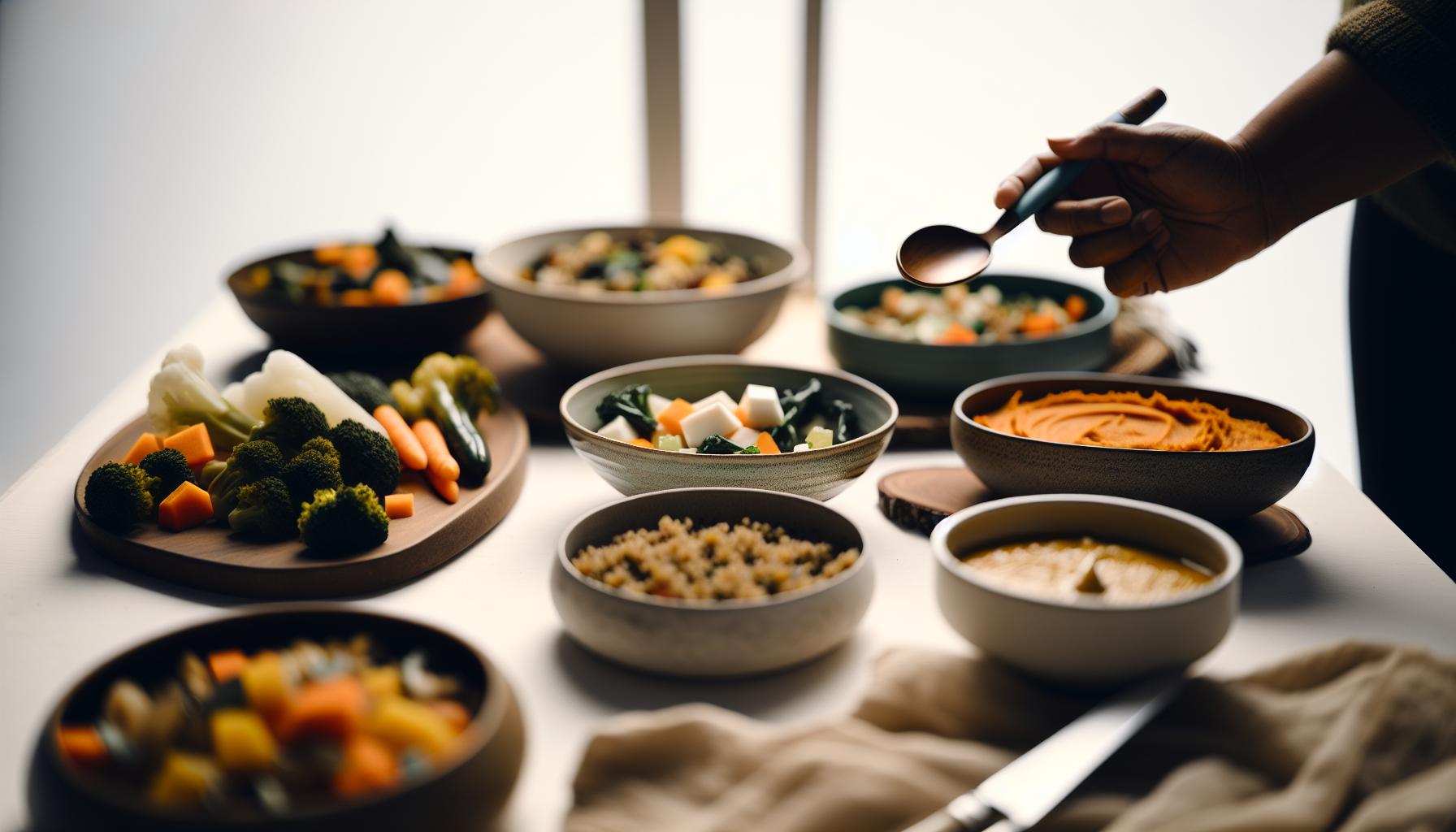Thanksgiving is a time for celebration, gratitude, and, of course, delicious food. For those managing diabetes, however, this holiday can bring feelings of anxiety about food choices and blood sugar levels. The good news is that you can enjoy the festive feast without fear. By understanding how to balance your meal, make mindful choices, and savor each bite, you can create a Thanksgiving experience that honors both your health and traditions. This article will provide you with practical tips and insights on navigating the holiday spread, ensuring you can participate fully in family gatherings while keeping your diabetes in check. Let’s explore how you can enjoy Thanksgiving with confidence and joy!
Understanding Diabetes: The Basics You Need to Know
Understanding diabetes is essential, especially during a festive time like Thanksgiving. Diabetes is a chronic condition that occurs when the body cannot produce enough insulin or cannot use insulin effectively. Insulin is crucial for regulating blood sugar levels, and its deficiency leads to persistent high blood sugar, which can result in serious health complications over time. According to the World Health Organization, diabetes can significantly impact various bodily systems, particularly the nerves and blood vessels, making awareness and management critical for those affected.
As we approach the holiday season, it’s vital to understand how to enjoy gatherings without compromising health. Practical steps can make a significant difference. Begin by familiarizing yourself with the types of food that typically appear on Thanksgiving tables, including rich stuffing, savory pies, and sweet desserts. Educating yourself about carbohydrate content is a good way to maintain balanced blood sugar levels. For example, choosing whole grains, such as quinoa or brown rice, instead of white bread can decrease the glycemic load of your meal, allowing for more stable blood sugar levels.
One effective strategy is to balance meals with a variety of food groups; prioritize proteins-like turkey or bean dishes-and incorporate healthy fats and fiber. Filling half your plate with non-starchy vegetables helps manage hunger and provides necessary nutrients. Additionally, monitor portion sizes to avoid blood sugar spikes. A practical tip is to use smaller plates to help control serving sizes visually.
Lastly, don’t underestimate the power of hydration and physical activity. Drinking water before and during meals can help regulate appetite, while staying active-be it through a post-meal walk or engaging in a game-can assist in managing blood sugar levels post-feast. Encouraging family members to join in on these activities fosters support and creates a healthier holiday atmosphere for everyone involved. Remember, while enjoying food is a big part of Thanksgiving, it’s equally essential to prioritize your health and well-being. Consulting with your healthcare provider about individual dietary needs and managing diabetes effectively is always recommended.
Navigating the Thanksgiving Feast: Essential Tips

Navigating the Thanksgiving feast can feel daunting, especially for those managing diabetes. However, with some practical preparation and smart choices, you can enjoy the joys of the holiday without compromising your health. One of the best strategies is to approach the feast with a game plan. Before arriving at your gathering, consider eating a small, balanced snack that includes protein and fiber. This will help minimize hunger and potential temptation around high-carb options.
When it comes time to fill your plate, aim for a variety of colors and textures. Prioritize non-starchy vegetables, which are low in carbohydrates and high in nutrients. Foods like roasted Brussels sprouts, green beans, and salads rich in leafy greens not only sustain your plate’s aesthetic appeal but also provide essential vitamins and help manage your blood sugar levels. Next, select lean proteins, such as turkey or lentil dishes, to keep you feeling full without the excessive carbohydrates that can accompany traditional stuffing and rolls. Remember to avoid fried items and heavy gravies that can spike your blood sugar.
Managing portion sizes plays a critical role in enjoying holiday meals responsibly. Use smaller plates to visually limit your servings, since larger plates can lead to overeating. Aim to fill half of your plate with vegetables, a quarter with lean proteins, and the remaining quarter with whole grains or starchy sides, paying attention to the carbohydrate content of these foods. You may also consider sharing desserts or opting for fruit-based desserts, which often contain natural sugars and can be lighter on your system.
Finally, don’t forget the importance of hydration and movement. Drinking water throughout the meal can help curb your appetite and assist with digestion. After eating, participate in light activities-like a family walk or participating in games with loved ones-which can help regulate blood sugar. This combination of thoughtful eating and physical activity contributes to a more balanced and enjoyable Thanksgiving, allowing you to partake in the festivities without fear. Always remember, consultation with your healthcare provider for personalized advice gives you the most robust plan for managing diabetes during this celebratory time.
Satisfying Sides: Diabetes-Friendly Recipe Ideas

When it comes to Thanksgiving, the sides can often take center stage, offering an opportunity to create delicious yet diabetes-friendly dishes that everyone can enjoy. It’s essential to consider the balance of flavors and textures while also keeping in mind the dietary needs of those managing diabetes. Making thoughtful ingredient choices can lead to satisfying sides that not only complement your main dish but also promote healthy blood sugar levels.
Start by exploring a variety of vegetable-based dishes that can add both nutritional value and vibrant color to your table. Roasted vegetables are a fantastic choice-think Brussels sprouts, sweet potatoes, and carrots-with a drizzle of olive oil and your favorite herbs. The roasting process enhances their natural sweetness without adding high-carb elements. Another enticing option is a mixed greens salad, topped with nuts, seeds, and a light vinaigrette. Including a variety of non-starchy vegetables like peppers, cucumbers, and tomatoes can provide essential vitamins while keeping the carbohydrate content low.
Healthy Grain Alternatives
While traditional stuffing is often loaded with bread, you can create a healthy alternative using quinoa or farro. These grains are not only higher in protein and fiber but also have a lower glycemic index compared to white bread. You can mix in sautéed onions, celery, and fresh herbs for that Thanksgiving classic feel. Another excellent side could be a cauliflower mash, which mimics the texture of mashed potatoes but significantly reduces carbs. Simply steam and blend cauliflower with garlic and a splash of vegetable broth for a creamy yet healthy twist.
Flavorful Legume Dishes
Incorporating legumes is another smart way to enhance your Thanksgiving spread. Lentils, for instance, are packed with protein and fiber and can be served as a warm salad mixed with diced tomatoes, onions, and a sprinkle of feta cheese. Chickpeas can be tossed into a roasted vegetable medley or blended into a healthy hummus dip to accompany raw veggies.
By integrating these diabetes-friendly side dishes into your Thanksgiving feast, you ensure that all your guests, including those managing diabetes, can enjoy delicious flavors without compromising their health. Encouraging everyone to savor their meals while being mindful of their choices fosters a festive atmosphere that celebrates togetherness and well-being. Always remember to consult with healthcare professionals for personalized dietary advice and options suited to individual health needs.
Dessert Delights: Indulge Without the Guilt

Indulging in the sweet delights of Thanksgiving doesn’t have to be a source of stress for those managing diabetes. The key to enjoying desserts without guilt lies in selecting ingredients that can satisfy sweet cravings while being mindful of blood sugar levels. This Thanksgiving, consider preparing treats that use natural sweeteners, whole grains, and nutritious additives, allowing everyone to partake in the dessert table.
One popular option is to create a pie using a whole grain or nut-based crust, which offers a lower glycemic index than traditional white flour crusts. For the filling, try using 100% pumpkin puree or homemade apple sauce sweetened with a touch of stevia or erythritol. These substitutes maintain the essence of traditional desserts while drastically reducing the sugar content. You can elevate the flavor with spices like cinnamon and nutmeg to add warmth and richness without the need for excess sugar.
Another fantastic idea is to whip up a batch of miniature fruit parfaits. Layer yogurt (opt for Greek yogurt or a plant-based alternative) with fresh berries and a sprinkle of nuts or seeds. This combination not only provides natural sweetness but also packs in protein and fiber, making it a fulfilling and health-conscious option. Additionally, choosing high-fiber fruits like berries, which have a lower glycemic index, helps keep blood sugar stable while still treating taste buds to something delightful.
If chocolate is more your speed, chocolate avocado mousse offers a decadent yet healthy alternative. Blending ripe avocados with cocoa powder, a hint of vanilla extract, and a sugar substitute can yield a rich dessert that is surprisingly nutritious. This dessert is not only low in sugar but also high in healthy fats, making it a great choice for the holiday season.
Remember, portion control remains vital even when enjoying diabetes-friendly desserts. Serve smaller portions and savor each bite to stay in tune with your body’s hunger cues. Encouraging everyone to share their dessert choices promotes a communal atmosphere where delicious, healthier alternatives can shine, allowing everyone to enjoy the holiday desserts without compromising on health or taste. Always consult with your healthcare provider for personalized advice, but don’t shy away from creating delicious memories.
Smart Portion Control: Enjoying Your Favorite Foods

Maintaining enjoyment during the Thanksgiving feast while managing diabetes can seem daunting, but understanding the importance of portion control can transform the experience into a celebratory and healthy occasion. Portion control not only allows for a variety of food choices but also helps prevent blood sugar spikes, enabling you to savor the holiday favorites without fear.
One effective strategy is to use smaller plates and utensils to create the illusion of a full meal without the excess calories. Research suggests that when we perceive our plates as full, we are more likely to feel satisfied, even with less food. Incorporating a balanced plate can also help: aim to fill half your plate with non-starchy vegetables, one-quarter with lean protein, and the remaining quarter with whole grains or starchy vegetables. This visual guideline helps ensure that you’re getting the nutrients you need while keeping carbohydrates in check, which is crucial for managing blood sugar levels.
It’s also beneficial to familiarize yourself with serving sizes. For instance, a standard serving of turkey is around 3 ounces, roughly the size of a deck of cards, whereas a serving of mashed potatoes should be about half a cup. Keeping a simple visual reference can help you make better choices without the need for weighing food. Mindful eating is another essential aspect; take your time to chew thoroughly and relish each bite, which can enhance satiety and minimize the urge to overeat.
Finally, encouraging the practice of sharing dishes among family members creates a communal atmosphere that promotes moderation. When everyone shares bites of their favorite foods, it reduces the temptation to overindulge while still enjoying a wide array of flavors. Remember, every interaction around food is an opportunity to celebrate togetherness and gratitude, key elements of Thanksgiving that can be enjoyed healthily. As you navigate these choices, always consult your healthcare provider for tailored advice and strategies that suit your individual needs, reinforcing that you can enjoy this festive time while maintaining your health.
Glycemic Index: Making Informed Food Choices
Understanding the glycemic index (GI) can be an empowering tool for those managing diabetes, especially during festive meals like Thanksgiving. The glycemic index ranks foods based on how quickly they raise blood glucose levels after consumption. Foods with a high GI are digested quickly, leading to rapid spikes in blood sugar, while low-GI foods result in a more gradual increase. This knowledge can help you make informed choices at the holiday feast, ensuring that you can enjoy a range of dishes without compromising your health.
When planning your Thanksgiving menu, aim to include more lower-GI options. For example, instead of opting for white bread or regular mashed potatoes, consider whole grain bread or sweet potatoes. Here’s a list of common Thanksgiving foods categorized by their GI levels:
- Low GI Foods:
- Sweet Potatoes (GI: 44)
- Whole Grain Bread (GI: 50)
- Legumes (GI: 30-40)
- Moderate GI Foods:
- Brown Rice (GI: 55)
- Couscous (GI: 65)
- Oatmeal (GI: 55)
- High GI Foods:
- White Bread (GI: 70)
- Mashed Potatoes with Butter (GI: 70)
- Stuffing (GI: 65-75)
By choosing dishes lower on the glycemic index, you can create a plate that not only tastes great but also helps maintain stable blood sugar levels. Pairing higher GI foods with protein or healthy fats can also mitigate their effect on blood glucose. For instance, serving turkey with a side of roasted vegetables instead of rich, carbohydrate-dense sides can provide a balanced approach to your holiday meal.
For anyone navigating diabetes, especially during high-stakes times like the holidays, always lean on your healthcare team for personalized recommendations. They can help you incorporate glycemic index principles into your meal plan in a way that suits your individual health needs. This proactive approach not only promotes better blood sugar management but can also make your Thanksgiving experience enjoyable and fulfilling.
Managing Blood Sugar: Strategies for the Holiday
Managing blood sugar effectively during the holidays is crucial for maintaining health, especially for those with diabetes. It’s important to approach festive meals like Thanksgiving with a game plan that allows for enjoyment while keeping blood glucose levels in check. One practical strategy is to maintain a balanced eating pattern by incorporating a variety of food groups. This includes proteins, healthy fats, and fiber-rich vegetables, which can help slow carbohydrate absorption and moderate blood sugar spikes.
Planning is key to a successful Thanksgiving. Before the feast begins, check your blood sugar levels and consider a light exercise session, such as a brisk walk. This can help optimize insulin sensitivity. When it comes to the meal, start with a broth-based soup or a fresh salad to fill you up with low-calorie options. Use the plate method by filling half your plate with non-starchy vegetables, one-quarter with lean protein, such as turkey, and one-quarter with whole grains or starchy foods. This visualization not only simplifies portion control but also encourages a balanced diet.
Another helpful strategy is to be mindful of your beverage choices. Sugary drinks can add unnecessary carbohydrates and lead to blood sugar spikes. Opt for water, herbal teas, or even sparkling water with a splash of lemon or lime. If indulging in alcohol, moderation is key, and pairing it with food can also mitigate its effects on blood glucose.
Don’t hesitate to communicate your needs during the family gathering. Engage your family members in discussions about your dietary preferences and blood sugar management. This openness not only fosters understanding but can also create a supportive environment. Remember, it’s okay to say no to certain dishes and prioritize your health; there are plenty of delicious options available that align with your dietary goals. After the feast, a post-meal walk with family can not only make room for conversation but can also be a gentle way to help manage blood sugar levels.
By taking these thoughtful approaches to navigate your Thanksgiving meal, you can participate joyfully without compromising your health. Always work closely with your healthcare team to tailor these strategies to your specific needs, which will empower you to enjoy the festivities while keeping your diabetes well-managed.
Staying Active: Incorporating Movement into Your Day
Incorporating movement into your Thanksgiving Day can make a significant difference in managing blood sugar levels and enhancing your overall enjoyment of the holiday. Engaging in physical activity doesn’t have to be a strenuous workout; even light activities can contribute to better glucose control and overall well-being. One effective way to promote movement is by planning a family walk before or after the feast. This simple activity not only helps counterbalance the effects of a big meal but also fosters family bonding and conversation. Choosing routes that are scenic or going to a local park can make it enjoyable for everyone involved.
Another fun option is to participate in active games or sports, depending on your family dynamics. Whether it’s a friendly game of touch football, basketball, or even a scavenger hunt around the yard, these activities will keep you moving while creating joyous memories. These types of playful engagements can encourage everyone, including those who may not typically be active, to participate and incorporate movement into their day.
Planning your day around movement can take various forms; consider these strategies:
- Set a Schedule: Prioritize time for movement on your day’s agenda, just like you would for mealtime. This could include an early morning stretch or tai chi session to start the festivities.
- Involve Everyone: Encourage family members of all ages to join in. Bring along equipment like a frisbee or a ball to engage younger family members or even set up an obstacle course.
- Share Your Goals: Communicate your desires to stay active with family, so they can support your efforts. They may even want to join you in making healthier choices!
After the meal, aim for a gentle 20-30 minute walk. This can assist in digestion and minimize post-meal blood sugar spikes. Remember, the key is consistency; making movement a part of your holiday tradition can lead to lasting positive habits. Always consult your healthcare team before making significant changes to your routine, especially if you have concerns related to diabetes management. By taking these steps, you can enjoy the festive day while effectively managing your health.
Family Dynamics: Discussing Diabetes During the Feast
It’s essential to create a supportive environment when discussing diabetes during family gatherings, especially at a feast like Thanksgiving. Many people might feel uncertain or even embarrassed about their dietary restrictions, so opening the dialogue can help demystify diabetes management and foster a sense of community. Sharing insights about maintaining blood sugar levels while enjoying the meal can encourage understanding and compassion among family members. This is an opportunity to educate loved ones about how food choices and portions impact health, enabling them to be supportive during the feast.
Consider setting aside time before the meal to discuss dietary preferences and any necessary adjustments. For example, if you need to avoid traditional high-carb dishes, you could share the importance of these choices and suggest alternatives that fit into the day’s menu. By explaining the concept of carbohydrate counting or the significance of balanced meals, families can work together to find creative solutions. Maybe they can join you in preparing a diabetes-friendly dish or exploring healthier versions of traditional recipes, showcasing that adaptation is possible without sacrificing flavor.
Communication can also alleviate stress, as family members may have questions or concerns about your dietary needs. Encourage them to ask openly without fear of offending. Additionally, sharing personal insights about how certain foods affect your health can promote empathy and understanding. For instance, explaining how a particular dish makes you feel can be more impactful than mere dietary regulations.
Lastly, remember that dining is not just about food but also connection. Suggest involving everyone in activities that celebrate togetherness, such as crafting a gratitude list or sharing personal stories, which can emphasize the importance of health alongside holiday traditions. Support your dialogue with resources like pamphlets or links to websites about diabetes management for family members curious about the condition. By framing discussions positively and constructively, you can create a warm, supportive atmosphere that celebrates not just the feast, but also your commitment to health and well-being.
Support Networks: Finding Help and Encouragement
Finding a support network during the holiday season can significantly ease the challenges of managing diabetes, especially during gatherings like Thanksgiving, where food and tradition play central roles. Surrounding oneself with understanding and empathetic individuals makes it easier to navigate dietary needs and lifestyle adjustments without feeling isolated. Many people benefit from connecting with friends, family, and healthcare professionals who understand and support their diabetes management goals.
One way to build your support network is to join community groups dedicated to diabetes education and management. These groups often provide resources, discussions, and workshops which can equip you with practical strategies to maintain your health during festive occasions. For instance, local diabetes organizations can offer insight into diabetic-friendly recipes, meal planning, and stress management techniques. Online forums and social media groups can also be excellent resources for exchanging experiences, tips, and encouragement with others who relate to your journey.
Reaching out to your healthcare team is equally important. They can assist with personalized advice on balancing your meal choices during Thanksgiving feasts. Setting an appointment before the holidays allows you to discuss potential challenges and create a tailored management plan that includes blood sugar monitoring strategies and medication adjustments if needed. Having a solid plan in place can give you confidence as you enjoy the holiday with loved ones.
Including family members in your health management can foster a more supportive atmosphere. Discussing your dietary preferences and inviting them to participate in planning can transform the meal preparation process into a collaborative effort. Many families enjoy cooking together, and this can be a chance to introduce diabetes-friendly adaptations to traditional dishes. By engaging your loved ones in your health journey, you not only create a safety net for yourself but also educate them, which may lead to more thoughtful food choices in the future.
Ultimately, building a supportive environment goes beyond just talking about food; it’s about creating connections and understanding. Whether it’s through friends who understand your situation, family who is willing to learn, or professional care providers who can offer expert advice, surrounding yourself with supportive people can transform your Thanksgiving experience from daunting to delightful.
Professional Guidance: Consulting Your Healthcare Team
Consulting your healthcare team is an essential step in taking control of your diabetes, especially during the holiday season when food choices can feel overwhelming. Engaging with professionals who understand the nuances of diabetes management can empower you to enjoy the Thanksgiving feast with confidence. The holidays don’t have to mean sacrificing your health; instead, they can be an opportunity to apply the skills and knowledge you’ve accumulated in consultation with your specialists.
Before the festivities begin, consider scheduling an appointment with your healthcare provider. This proactive step will allow you to discuss specific concerns, such as managing portion sizes and choosing foods that support your blood sugar control. During the appointment, you can develop a tailored plan that might include recommendations for medication adjustments or strategies for monitoring your blood sugar levels before, during, and after meals. Additionally, you can create a list of diabetic-friendly dishes that can be enjoyed alongside traditional holiday staples, ensuring that you don’t miss out on the holiday spirit.
Types of Professionals to Consult
- Primary Care Physician: Your main doctor can provide guidance on overall diabetes management and preventive care.
- Endocrinologist: A specialist in hormones and metabolism, they can help optimize your diabetes treatment plan.
- Registered Dietitian: A dietitian can offer in-depth nutritional advice, helping you craft a Thanksgiving meal plan that fits your dietary needs and preferences.
- CDE (Certified Diabetes Educator): They can equip you with practical knowledge and strategies to navigate meal planning and carbohydrate counting.
Having a plan in place not only prepares you for the feast but also alleviates anxiety about food choices. This empowers you to focus more on enjoying time with family and friends rather than worrying about potential spikes in blood sugar. Remember, your healthcare team is there to help you navigate your individual challenges, offering tailored advice to enhance your Thanksgiving experience without fear.
In addition to family support, having the backing of your healthcare team can facilitate open discussions about your dietary preferences with loved ones. Their insights can help your family understand the significance of your dietary choices and encourage them to assist you in meal preparation. In doing so, you create an inclusive environment that resonates with the spirit of Thanksgiving-gratitude, family, and love-while prioritizing your health.
Shopping Smart: Selecting Diabetic-Friendly Ingredients
Shopping for diabetic-friendly ingredients during the holiday season can feel daunting, but with the right approach, it can also be an empowering experience. When you’re navigating the aisles of your local grocery store, focus on selecting ingredients that promote blood sugar stability while still allowing you to enjoy a festive Thanksgiving feast.
Start by making a comprehensive shopping list that includes fresh vegetables, lean proteins, and whole grains. Opt for non-starchy vegetables like spinach, broccoli, and cauliflower, as these provide essential nutrients without spiking blood sugar. Lean meats, such as turkey or chicken breast, are excellent choices as they are low in saturated fat and high in protein, which helps manage hunger and blood sugar levels. Whole grains like quinoa, brown rice, and whole-grain bread can provide fiber and complex carbohydrates that are digested more slowly, keeping blood sugar levels steadier.
When it comes to purchasing pantry staples, be vigilant about reading food labels. Look for products with no added sugars, high fiber content, and lower carbohydrate counts. Avoid items laden with preservatives and high fructose corn syrup. In many cases, opting for natural sweeteners like stevia or monk fruit can satisfy your sweet tooth without negatively impacting your blood sugar. Don’t forget to stock up on healthy fats, such as avocados, nuts, and olive oil; these can help enhance flavors while also providing satiety.
Creating a balanced shopping experience not only facilitates your understanding of diabetes management but also demonstrates to your family the importance of healthy choices during gatherings. Consider involving family members in the shopping process; it’s a wonderful opportunity to discuss your dietary needs, share recipe ideas, and get their support for creating a festive but diabetic-friendly Thanksgiving meal. By approaching holiday shopping with intention and care, you can enjoy a delicious feast that aligns with your health goals while celebrating the spirit of the season.
Faq
Q: How can I enjoy Thanksgiving dinner with diabetes?
A: Enjoying Thanksgiving with diabetes is possible by planning ahead. Focus on portion control and choose healthier options like roasted vegetables or lean proteins. Prioritize low-glycemic index foods to help manage blood sugar levels. Don’t hesitate to discuss your dietary needs with family to foster understanding and support.
Q: What are some diabetic-friendly Thanksgiving foods?
A: Diabetic-friendly Thanksgiving foods include roasted turkey (without skin), green bean casserole (made with low-fat ingredients), and whole-grain stuffing. Opt for naturally sweetened desserts like pumpkin pie made with a sugar substitute. For more recipes, refer to our “Satisfying Sides: Diabetes-Friendly Recipe Ideas” section.
Q: How do I manage my blood sugar levels after Thanksgiving dinner?
A: To manage blood sugar after Thanksgiving dinner, consider taking a short walk post-meal to enhance insulin sensitivity. Monitor your blood sugar levels frequently, and drink plenty of water to stay hydrated. For additional strategies, check our section on “Managing Blood Sugar: Strategies for the Holiday.”
Q: Can I have dessert on Thanksgiving if I have diabetes?
A: Yes, you can enjoy dessert on Thanksgiving! Choose options that are lower in sugar and carbohydrates, like fruit salad or a small slice of sugar-free pie. It’s important to practice moderation and space out your treats. Explore more in our “Dessert Delights: Indulge Without the Guilt” section.
Q: What tips can help me stick to my diabetes management plan on Thanksgiving?
A: To stick to your diabetes management plan during Thanksgiving, plan your meals in advance, focus on balanced portions, and keep track of your carbohydrate intake. Engage your family in discussions about your diabetes to ensure a supportive environment.
Q: Is carbohydrate counting necessary for Thanksgiving meals?
A: Yes, carbohydrate counting is beneficial for Thanksgiving meals to help manage blood sugar. Understanding the carb content of dishes can assist you in making informed choices and maintaining control over your intake. This is discussed more in our “Glycemic Index: Making Informed Food Choices” section.
Q: How can I involve family members in my diabetes management during Thanksgiving?
A: Involve family members in your diabetes management by educating them about your dietary needs and preferences. Share your favorite diabetic-friendly recipes with them to incorporate into the feast. Encouragement from loved ones can significantly enhance your experience during the holiday.
Q: Where can I find support for managing diabetes during holidays?
A: You can find support for managing diabetes during holidays through local diabetes support groups or online forums. Consulting with healthcare professionals, as discussed in our “Professional Guidance: Consulting Your Healthcare Team,” can also provide tailored advice for navigating festive meals.
Concluding Remarks
As Thanksgiving approaches, remember that enjoying the feast doesn’t have to be overwhelming for those managing diabetes. By integrating smart food choices and mindfulness into your celebrations, you can savor all the flavors of the season without fear. Embrace our tips to celebrate a healthy Thanksgiving, and if you want to dive deeper, check out our guides on daily diabetes management and crafting delicious diabetic-friendly recipes.
Don’t let questions linger-reach out to healthcare professionals or explore our resources on medical care and diabetic products. Whether you’re seeking meal planning ideas or advice on lifestyle considerations for diabetes, we have invaluable content waiting for you. Sign up for our newsletter for ongoing insights and support, and consider sharing your thoughts or experiences in the comments below to connect with a community that understands. Let’s make this Thanksgiving not just about the food, but about health, togetherness, and gratitude.












